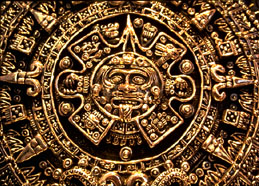|
|
Most of the ancient civilizations, including the Sumerians, Greeks, Mayans, and Egyptians, had a
sun-god of some sort in their religious framework. The Sun Dance was an important ritual for the North American Plains Indians. Anasazi and Mayan people built sun observatories and used their findings to calculate time and weather patterns. For these people, the sun was often seen as the source of life, but also as a source
of death and harsh control. In some cases, the religion centered on sun worship and in others it was part of a
larger scheme. But the importance of the sun for these ancient peoples is clear in their stories and beliefs.
|
- The ancient Chinese people believed that there were actually 10 suns. The sun had such a powerful light and effect on their lives that they felt it must come from more than one source.
|
- The oldest known sundial is in Southern Egypt and is thought to be over 6,000 years old. The stone structure, located in Nabta, was used to record the passing seasons.
|
- In many early cultures, especially in the northern or central areas of the world, the sun was the focus of life because of its
role in crop growth and seasons. Stonehenge is an ancient solar observatory illustrating the importance of
the sun in an agricultural society.
|
- Sumerians honored the sun-god Utu among their panthenon as
early as 3000 BCE. However Utu was not among the most powerful of their gods, and seems to have been worshipped in
tandem with moon and water gods. The sun and other planetary bodies were often associated with anthropomorphic gods in
general.
|
- The Akkadians extended the Sumerian notion of a sun-god to form a cult devoted to that
worship. Soon the sun god Shamash was unrivaled in Akkadian culture and became the subject of temples, hymns, stories,
and art.
|
- Ancient Egyptians honored Ra-Atum-Khepri, the manifestation of
God in the sun. They held that Ra created the first divine couple. Human life, too, came from the tears of Ra.
The Pharaohs were believed to be the successors of the first
king, who was the creator Ra. Because of this belief the pharaohs deeds and gestures were described in the same terms used
to describe the actions of the Sun god Ra. Light was a symbol of life, and this was made especially clear through
Ra. Aton, often called the supreme god, holds a solar disk in his hands, suggesting that his strength comes from
the light of the sun.
|
- The Greeks worshipped Apollo as a god connected to the sun, but
soon tied him to the arts, music, and mathematics. This proved to be an important step, as the sun would be influencial
in human advancement in all these areas and the subject of much debate and inquiry.
|
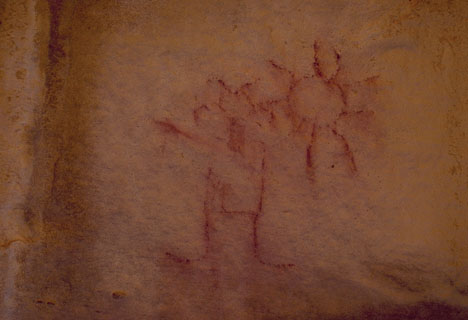
|
This image (courtesty of Ron Lussier, LikeMinds.com) is a Chaco Canyon petrograph of a man and sun. It was created
by Anasazi (ancient inhabitants of the Americas) between 900 and 1130 CE.
|
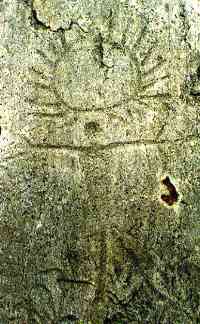
|
Here is another image of a man and the sun (from the solar center at Stanford University); this one dates from the Copper Age and was found in the Alps mountain range.
|
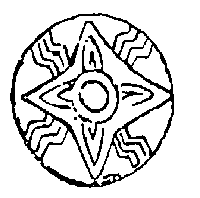
|
As discussed above, the ancient Akkadians refered to the sun as Shamash. This is a common symbol used to represent this god and the sun in general
for both the Akkadians and Sumerians. It is hard for me to see the clear connection to the basic image of a circle and rays, but this
symbol was in use throughout Mesopotamia at the time. (image from http://www.bearfabrique.org/Saturn/rockart.html)
|
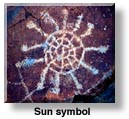
|
Ancient peoples of the Americas also used the sun prominently in their artwork. Often, it was represented by a
circle with lines extending from the center, a concentration of dots in a circular pattern, or as a spiral. The image on the left comes from the Great Basin Desert in the southwest of the United States.
|
|
|
The sun has been a part of astronomical and scientific inquiry for centuries, which is not surprising given its prominant
plave in the lives of men. But it has not always held the same position that we currently place it in. Our understanding
of the sun and its relationship to us on Earth is a constantly evolving study. Here are some key steps in that
evolution.
|
- Geocentric or Heliocentric?
Aristotle was an early developer of the geocentric view of the solar system, placing Earth at the
center, around 384 to 322 BCE. However, Ptolemy, another Greek, is more generally credited with the promotion and refinement
of a geocentric universe.
This error would remain the dominant view well into the modern age. Using only logic and observation, early
sun watchers believed that if the Earth was in motion, they would see stars change places. As they did not observe this, they mistakenly
concluded that the sun was the body in constant motion.
A breakthrough in understanding the sun came in 1543, when Copernicusreguted Ptolemy and posited a
heliocentric view of solar movement. We now know that he was correct, but the public could not accept that the
Earth rotated around the sun for many years.
In 1610, Galileo published his first work confirming Copernicus' theory of a sun-centered universe. Although Galileo
came under heavy fire from both religious and secular sources and was eventually forced to retract his statements,
his research and observations are with us today as a landmark in solar history.
|
- Hipparchus, born in 190 BCE in what is now Turkey, contributed in a very practical way to our
understanding of the sun's impact on our lives. Using only his eyes and power of observation, he calculated the length of
a solar-based year to within 6 hours of current measurements. By noting the positions of the sun, planets, and stars
in the sky, Hipparchus was able to determine the regular equinoxes and the relative brightnesses of stars when compared to the sun.
From this, he posited relative distances.
|
- In 1816, photography was invented. This soon allowed for actual photographs of solar bodies, eventually even
the sun. By 1845, the first series of sun photographs was taken. Over the years, the techinque has been refined so
that we can currently marvel not only at close-up images of detailed solar-flare activity, but also examine images of the sun's
temperature, motion, and internal gases.
|
- Back in 1610, Galileo and Johann Goldsmid discovered sunspots. Their work led to many others and the study of sunspots
continues to this day. In 1843, Schwabe noticed a cyclical pattern to sunspots and their frequency in appearence. By 1852, Rudolph
Wolf demonstrated that this cycle was 11 years long. 1908 promised another development: Hale discovered magnetic fields in
sunspots.
|
- In 1946, the first observations of solar ultraviolet rayswere recorded. They were soon followed by solar x-rays in 1949 using a sounding rocket and observation of solar gamma rays by the Orbiting Solar Observatory I in 1963. Eventually, researchers were recording emissions from the sun across the entire spectrum of light.
|
- One of the greatest scientific achievements in solar observation began in 1994, when Ulysses flew over polar regions of the sun. This is proof that the research must and does continue, as we try to learn more about the sun.
|
